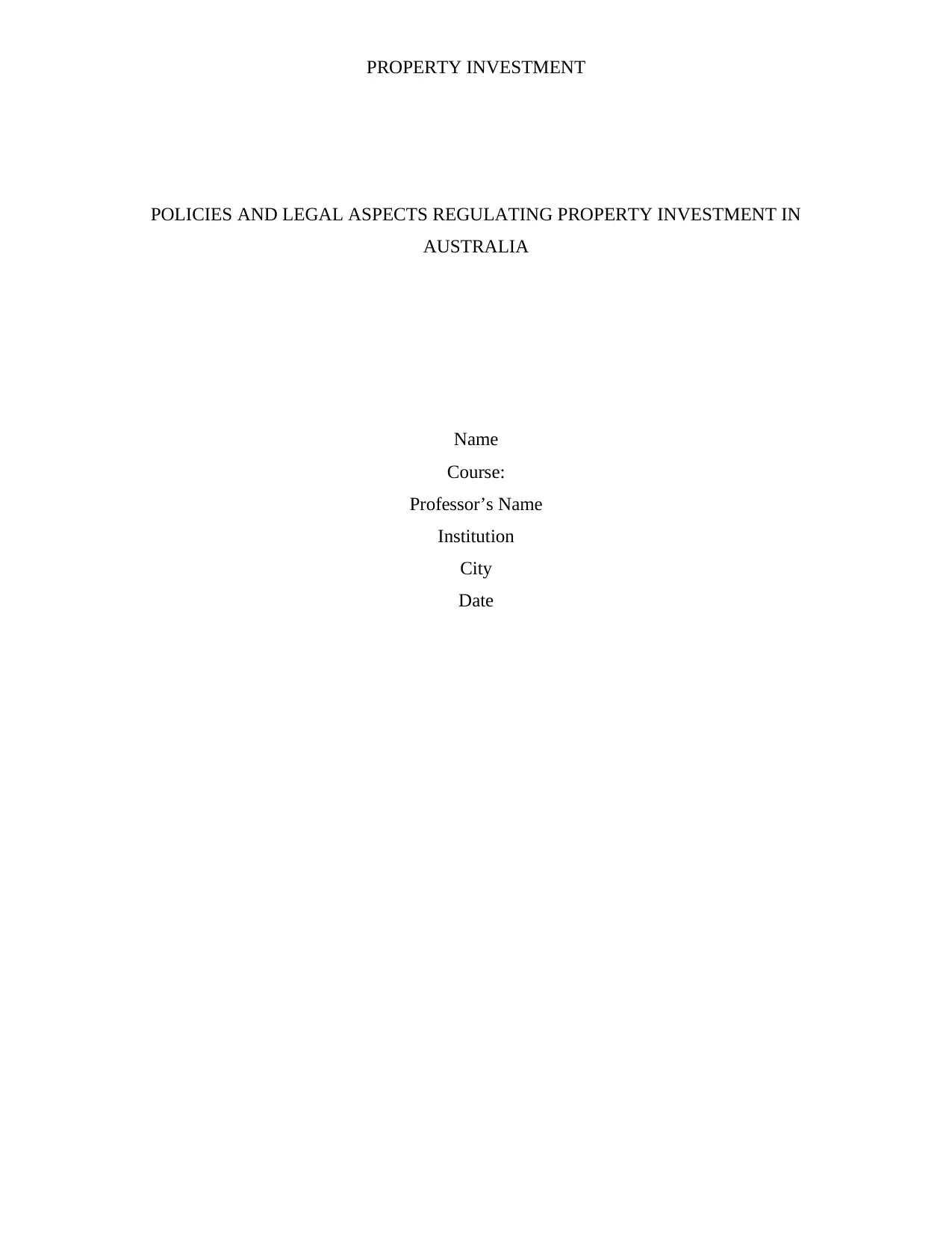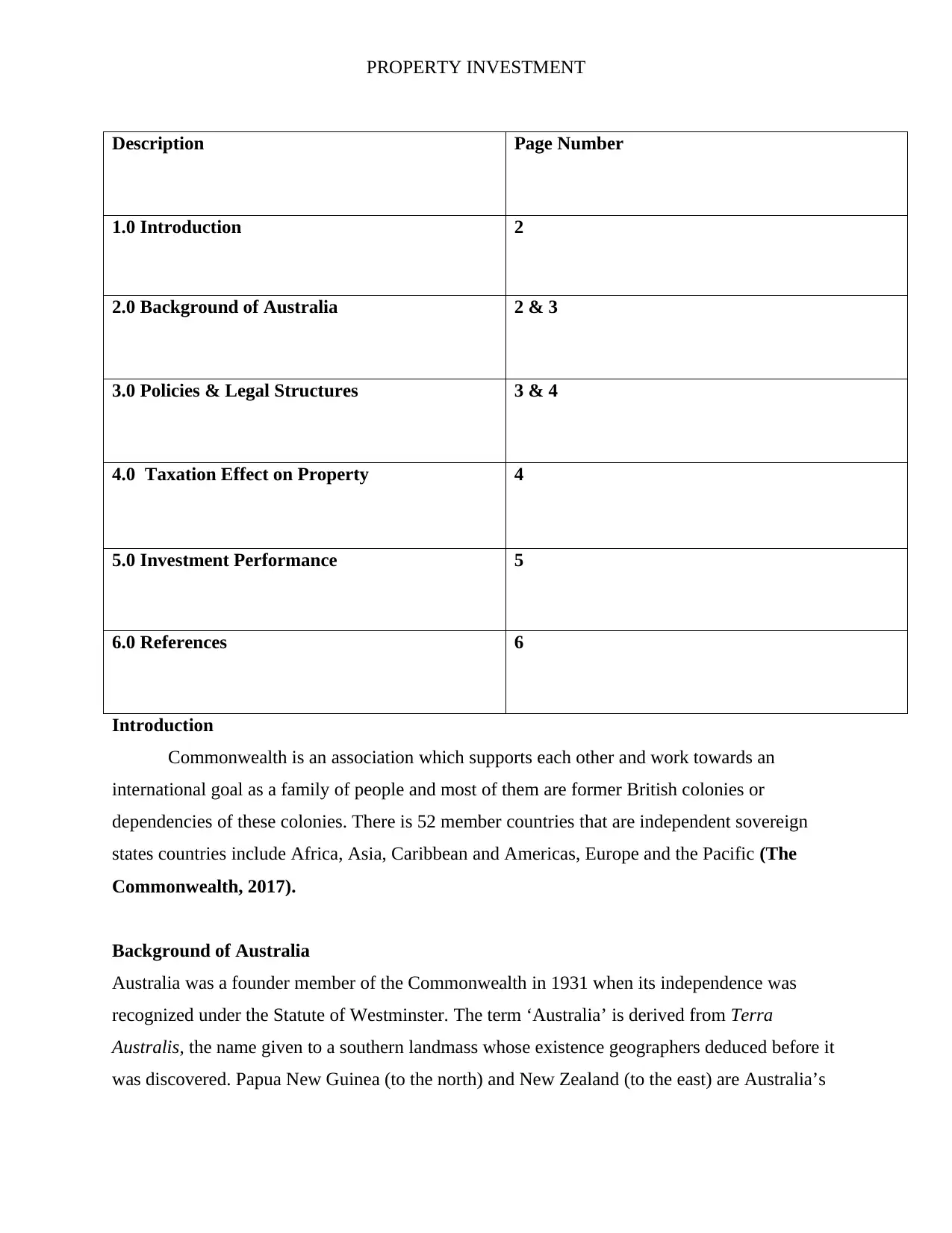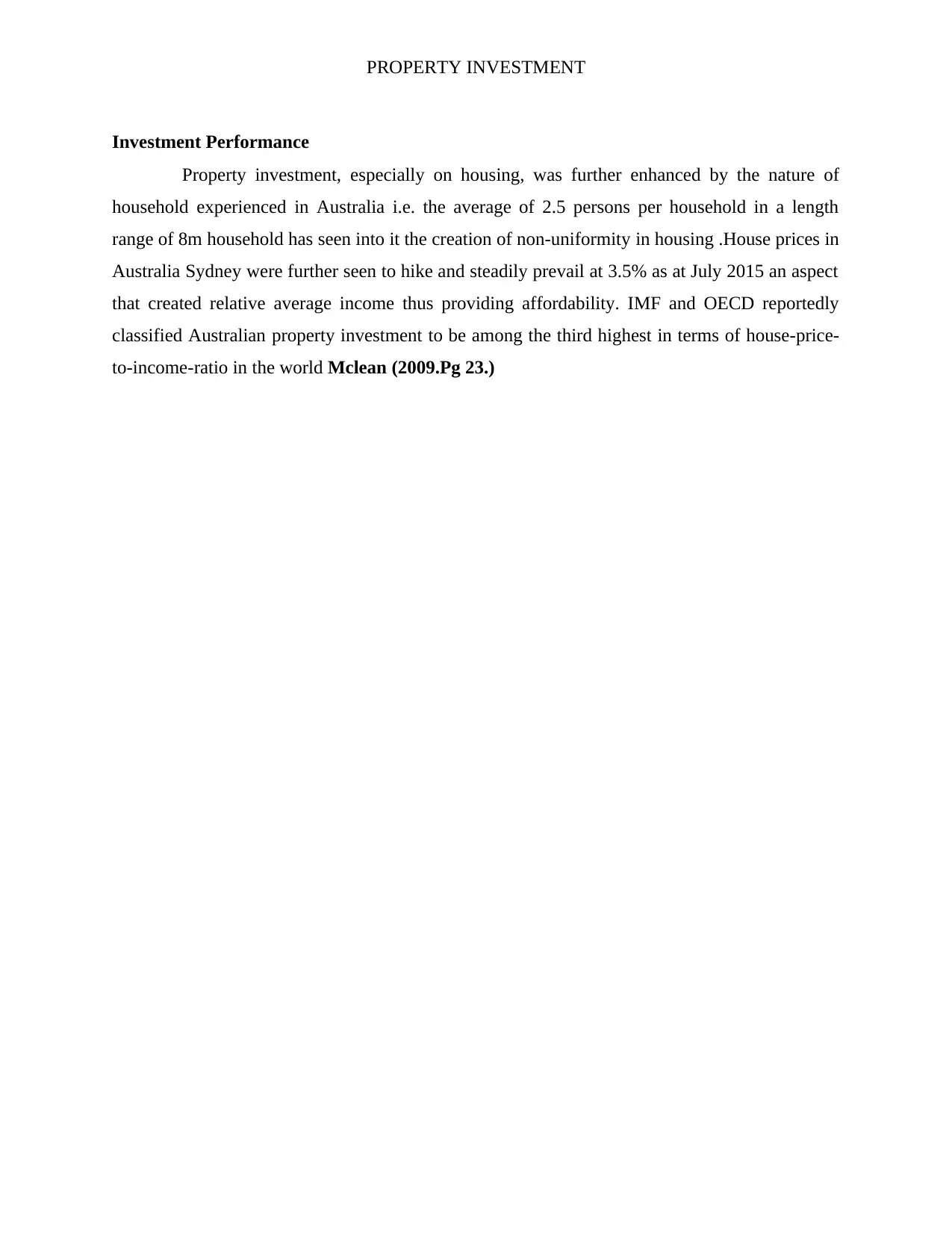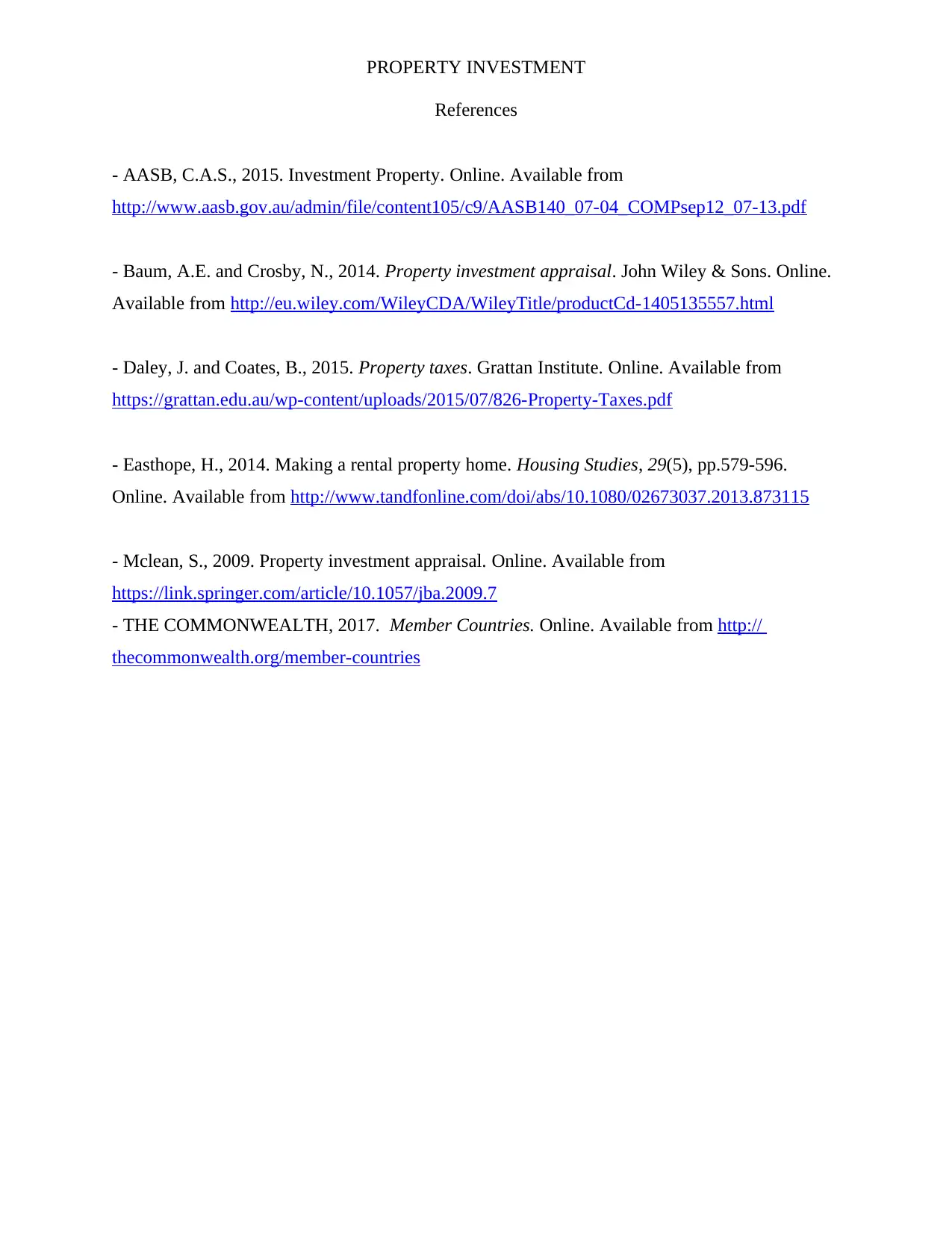LJMU - Property Investment Policies and Legal Aspects in Australia
VerifiedAdded on 2023/06/15
|6
|1310
|229
Report
AI Summary
This report provides an overview of property investment policies and legal aspects in Australia, focusing on the regulatory environment and its impact on investment performance. It begins with a background of Australia within the Commonwealth, then delves into the policies and legal structures governing property investment, highlighting the willing buyer willing seller principle and the average 4% annual growth in property investment. The report discusses land planning laws, credit facility controls, and taxation effects, including capital gains tax concessions and tax deductions for losses. It also addresses restrictions on property sizes, land usage, and foreign investment to control property prices. The investment performance section notes the household dynamics and house price trends, classifying Australian property investment among the highest in terms of house-price-to-income ratio. The report concludes with a list of references used in the analysis. This student-contributed document is available on Desklib, where students can find a wide array of study resources.

PROPERTY INVESTMENT
POLICIES AND LEGAL ASPECTS REGULATING PROPERTY INVESTMENT IN
AUSTRALIA
Name
Course:
Professor’s Name
Institution
City
Date
POLICIES AND LEGAL ASPECTS REGULATING PROPERTY INVESTMENT IN
AUSTRALIA
Name
Course:
Professor’s Name
Institution
City
Date
Paraphrase This Document
Need a fresh take? Get an instant paraphrase of this document with our AI Paraphraser

PROPERTY INVESTMENT
Description Page Number
1.0 Introduction 2
2.0 Background of Australia 2 & 3
3.0 Policies & Legal Structures 3 & 4
4.0 Taxation Effect on Property 4
5.0 Investment Performance 5
6.0 References 6
Introduction
Commonwealth is an association which supports each other and work towards an
international goal as a family of people and most of them are former British colonies or
dependencies of these colonies. There is 52 member countries that are independent sovereign
states countries include Africa, Asia, Caribbean and Americas, Europe and the Pacific (The
Commonwealth, 2017).
Background of Australia
Australia was a founder member of the Commonwealth in 1931 when its independence was
recognized under the Statute of Westminster. The term ‘Australia’ is derived from Terra
Australis, the name given to a southern landmass whose existence geographers deduced before it
was discovered. Papua New Guinea (to the north) and New Zealand (to the east) are Australia’s
Description Page Number
1.0 Introduction 2
2.0 Background of Australia 2 & 3
3.0 Policies & Legal Structures 3 & 4
4.0 Taxation Effect on Property 4
5.0 Investment Performance 5
6.0 References 6
Introduction
Commonwealth is an association which supports each other and work towards an
international goal as a family of people and most of them are former British colonies or
dependencies of these colonies. There is 52 member countries that are independent sovereign
states countries include Africa, Asia, Caribbean and Americas, Europe and the Pacific (The
Commonwealth, 2017).
Background of Australia
Australia was a founder member of the Commonwealth in 1931 when its independence was
recognized under the Statute of Westminster. The term ‘Australia’ is derived from Terra
Australis, the name given to a southern landmass whose existence geographers deduced before it
was discovered. Papua New Guinea (to the north) and New Zealand (to the east) are Australia’s

PROPERTY INVESTMENT
closest neighbours. To the south lie the Southern Ocean and Antarctica (The Commonwealth,
2017).
The Commonwealth of Australia is a Federation with six states – New South Wales (state capital
Sydney), Victoria (Melbourne), Queensland (Brisbane), South Australia (Adelaide), Western
Australia (Perth) and Tasmania (Hobart) – and two territories, Northern Territory (capital
Darwin) and the Australian Capital Territory, where the federal capital, Canberra, is situated.
Australia also has external territories (described in the profiles following this one). These have
small populations or are uninhabited and, apart from the vast Australian Antarctic Territory, are
small islands (The Commonwealth, 2017).
Policies & Legal Structures
Australia by virtue of being a colony of British they use modified policies, laws and
regulations that govern, control and manage the manner in which they do business. These
guidelines create a fair ground for persons investing as well as promoting the ease aspect of
doing business without fear of losing money. Ideally, the aspect of willing buyer willing seller is
profoundly expected to be safeguarded by the regulation and policies whose origin is based on
the commonwealth ground. Property investment in Australia involves a wide spectrum of
activities rotating across land trading and land value addition via the construction of fixtures on
the land. Property investment in Australia over the years has shown robust growth of an average
of 4% annually. Real estates and housing rates in Australia since the 1990s were further seen to
rise by 6% per annum on gradual scale basis thus attracting more investors close to the property
market in Australia Baum (2014.Pg 11).
Australian property investments are more likely to suffer mischief, victimization, and
compromise thus the need to introduce policies, legal structures, and regulation to guide the
latter. However, these policies are either seen to promote or to protect the investment.
Implementation of land planning laws restricted and ration land usage system both in rural and
urban areas hence controlled green-land development in lieu of infill development. The land
planning system main purpose was to control and lower the cost of housing Easthope (2014.Pg
580).
Control of credit facility via bank interest rates and bank policy has seen into it the ease
of provision of credit facility for the finance of the investment at returnable value. Australian
Reserve Bank over the years has been implementing this policy so as to boost persons willing to
closest neighbours. To the south lie the Southern Ocean and Antarctica (The Commonwealth,
2017).
The Commonwealth of Australia is a Federation with six states – New South Wales (state capital
Sydney), Victoria (Melbourne), Queensland (Brisbane), South Australia (Adelaide), Western
Australia (Perth) and Tasmania (Hobart) – and two territories, Northern Territory (capital
Darwin) and the Australian Capital Territory, where the federal capital, Canberra, is situated.
Australia also has external territories (described in the profiles following this one). These have
small populations or are uninhabited and, apart from the vast Australian Antarctic Territory, are
small islands (The Commonwealth, 2017).
Policies & Legal Structures
Australia by virtue of being a colony of British they use modified policies, laws and
regulations that govern, control and manage the manner in which they do business. These
guidelines create a fair ground for persons investing as well as promoting the ease aspect of
doing business without fear of losing money. Ideally, the aspect of willing buyer willing seller is
profoundly expected to be safeguarded by the regulation and policies whose origin is based on
the commonwealth ground. Property investment in Australia involves a wide spectrum of
activities rotating across land trading and land value addition via the construction of fixtures on
the land. Property investment in Australia over the years has shown robust growth of an average
of 4% annually. Real estates and housing rates in Australia since the 1990s were further seen to
rise by 6% per annum on gradual scale basis thus attracting more investors close to the property
market in Australia Baum (2014.Pg 11).
Australian property investments are more likely to suffer mischief, victimization, and
compromise thus the need to introduce policies, legal structures, and regulation to guide the
latter. However, these policies are either seen to promote or to protect the investment.
Implementation of land planning laws restricted and ration land usage system both in rural and
urban areas hence controlled green-land development in lieu of infill development. The land
planning system main purpose was to control and lower the cost of housing Easthope (2014.Pg
580).
Control of credit facility via bank interest rates and bank policy has seen into it the ease
of provision of credit facility for the finance of the investment at returnable value. Australian
Reserve Bank over the years has been implementing this policy so as to boost persons willing to
⊘ This is a preview!⊘
Do you want full access?
Subscribe today to unlock all pages.

Trusted by 1+ million students worldwide

PROPERTY INVESTMENT
invest in properties. However though the banks chip in to boost the property market, there are
restrictions on how persons use their land ownership titles to secure that finance this is just
limited to protect the difficulty in meeting loan or mortgage obligations.
Taxation effect towards property investment
Capital gain tax concession has further seen to promote property investment compared to
other investments over the years. Likewise, Australian tax system on tax incentives especially on
the tax deduction for losses incurred has seen to favor property investment Daley (2015.Pg 26).
Property restriction in Australia was geared by the random increase in properties prices
thus forcing the state to restrict on; the average floor area of the current houses being built thus
no one is allowed to do his own floor outside the one set in place, land usage restriction was also
set in place so as to curb high density in land use. Likewise, there existed limitation on green-
field construction only rather than infill development to facilitate high urban occupancy rate
AASB (2015.Pg 13).
Property foreign investor in Australia is only limited to invest in only real estate
investment that only tops up the housing stocks level. Foreign investors are further confined to
screen an investigation by the Australian Foreign Investment Panel to see into it whether indeed
they worth purchasing any property. Likewise, they are restricted to be selling the properties as
they leave not to hold or pass over to own persons and finally they are restricted to construct on
bear land to control land banking within their two years of stay. All these restrictions are made to
curb the increase in Australian property price index AASB (2015.Pg 13)
Tax control system over the years has been seen to be the controlling factor in most
investment field thus by tasking the Australian Tax Office to implement the regulation on means
of disposing of the properties and how to account for all income generated by the property. This
is mostly done by ensuring that all income relating to properties generated are declared and
respective returns filed so as to boost the state as well as involving the state in the investment.
Any gain on any investment property disposed of in Australia is further subjected to CGT tax on
the basis that it has been generating income Daley (2015.Pg 26).
invest in properties. However though the banks chip in to boost the property market, there are
restrictions on how persons use their land ownership titles to secure that finance this is just
limited to protect the difficulty in meeting loan or mortgage obligations.
Taxation effect towards property investment
Capital gain tax concession has further seen to promote property investment compared to
other investments over the years. Likewise, Australian tax system on tax incentives especially on
the tax deduction for losses incurred has seen to favor property investment Daley (2015.Pg 26).
Property restriction in Australia was geared by the random increase in properties prices
thus forcing the state to restrict on; the average floor area of the current houses being built thus
no one is allowed to do his own floor outside the one set in place, land usage restriction was also
set in place so as to curb high density in land use. Likewise, there existed limitation on green-
field construction only rather than infill development to facilitate high urban occupancy rate
AASB (2015.Pg 13).
Property foreign investor in Australia is only limited to invest in only real estate
investment that only tops up the housing stocks level. Foreign investors are further confined to
screen an investigation by the Australian Foreign Investment Panel to see into it whether indeed
they worth purchasing any property. Likewise, they are restricted to be selling the properties as
they leave not to hold or pass over to own persons and finally they are restricted to construct on
bear land to control land banking within their two years of stay. All these restrictions are made to
curb the increase in Australian property price index AASB (2015.Pg 13)
Tax control system over the years has been seen to be the controlling factor in most
investment field thus by tasking the Australian Tax Office to implement the regulation on means
of disposing of the properties and how to account for all income generated by the property. This
is mostly done by ensuring that all income relating to properties generated are declared and
respective returns filed so as to boost the state as well as involving the state in the investment.
Any gain on any investment property disposed of in Australia is further subjected to CGT tax on
the basis that it has been generating income Daley (2015.Pg 26).
Paraphrase This Document
Need a fresh take? Get an instant paraphrase of this document with our AI Paraphraser

PROPERTY INVESTMENT
Investment Performance
Property investment, especially on housing, was further enhanced by the nature of
household experienced in Australia i.e. the average of 2.5 persons per household in a length
range of 8m household has seen into it the creation of non-uniformity in housing .House prices in
Australia Sydney were further seen to hike and steadily prevail at 3.5% as at July 2015 an aspect
that created relative average income thus providing affordability. IMF and OECD reportedly
classified Australian property investment to be among the third highest in terms of house-price-
to-income-ratio in the world Mclean (2009.Pg 23.)
Investment Performance
Property investment, especially on housing, was further enhanced by the nature of
household experienced in Australia i.e. the average of 2.5 persons per household in a length
range of 8m household has seen into it the creation of non-uniformity in housing .House prices in
Australia Sydney were further seen to hike and steadily prevail at 3.5% as at July 2015 an aspect
that created relative average income thus providing affordability. IMF and OECD reportedly
classified Australian property investment to be among the third highest in terms of house-price-
to-income-ratio in the world Mclean (2009.Pg 23.)

PROPERTY INVESTMENT
References
- AASB, C.A.S., 2015. Investment Property. Online. Available from
http://www.aasb.gov.au/admin/file/content105/c9/AASB140_07-04_COMPsep12_07-13.pdf
- Baum, A.E. and Crosby, N., 2014. Property investment appraisal. John Wiley & Sons. Online.
Available from http://eu.wiley.com/WileyCDA/WileyTitle/productCd-1405135557.html
- Daley, J. and Coates, B., 2015. Property taxes. Grattan Institute. Online. Available from
https://grattan.edu.au/wp-content/uploads/2015/07/826-Property-Taxes.pdf
- Easthope, H., 2014. Making a rental property home. Housing Studies, 29(5), pp.579-596.
Online. Available from http://www.tandfonline.com/doi/abs/10.1080/02673037.2013.873115
- Mclean, S., 2009. Property investment appraisal. Online. Available from
https://link.springer.com/article/10.1057/jba.2009.7
- THE COMMONWEALTH, 2017. Member Countries. Online. Available from http://
thecommonwealth.org/member-countries
References
- AASB, C.A.S., 2015. Investment Property. Online. Available from
http://www.aasb.gov.au/admin/file/content105/c9/AASB140_07-04_COMPsep12_07-13.pdf
- Baum, A.E. and Crosby, N., 2014. Property investment appraisal. John Wiley & Sons. Online.
Available from http://eu.wiley.com/WileyCDA/WileyTitle/productCd-1405135557.html
- Daley, J. and Coates, B., 2015. Property taxes. Grattan Institute. Online. Available from
https://grattan.edu.au/wp-content/uploads/2015/07/826-Property-Taxes.pdf
- Easthope, H., 2014. Making a rental property home. Housing Studies, 29(5), pp.579-596.
Online. Available from http://www.tandfonline.com/doi/abs/10.1080/02673037.2013.873115
- Mclean, S., 2009. Property investment appraisal. Online. Available from
https://link.springer.com/article/10.1057/jba.2009.7
- THE COMMONWEALTH, 2017. Member Countries. Online. Available from http://
thecommonwealth.org/member-countries
⊘ This is a preview!⊘
Do you want full access?
Subscribe today to unlock all pages.

Trusted by 1+ million students worldwide
1 out of 6
Related Documents
Your All-in-One AI-Powered Toolkit for Academic Success.
+13062052269
info@desklib.com
Available 24*7 on WhatsApp / Email
![[object Object]](/_next/static/media/star-bottom.7253800d.svg)
Unlock your academic potential
Copyright © 2020–2026 A2Z Services. All Rights Reserved. Developed and managed by ZUCOL.





